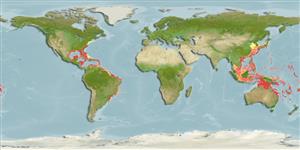Environment: milieu / climate zone / depth range / distribution range
Sinh thái học
Biển Cùng sống ở rạn san hô; Mức độ sâu 1 - 110 m (Ref. 26938), usually 10 - 50 m (Ref. 5217). Tropical; 22°C - 28°C (Ref. 130653); 41°N - 33°S
Western Atlantic: Canada (Ref. 5951) to New York (USA), Bermuda, and northern Gulf of Mexico to southern Brazil.
Bộ gần gũi / Khối lượng (Trọng lượng) / Age
Maturity: Lm ? range ? - ? cm
Max length : 18.0 cm TL con đực/không giới tính; (Ref. 26340); common length : 12.0 cm TL con đực/không giới tính; (Ref. 5217)
Các tia vây lưng cứng (tổng cộng) : 0; Các vây lưng mềm (tổng cộng) : 76 - 91; Tia cứng vây hậu môn: 0; Tia mềm vây hậu môn: 58 - 69. Light tan to light gray with irregular pale rings or rosettes, some of which are dark-edged; scattered small dark spots and three large blackish spots along straight portion of lateral line, the middle one the best defined (Ref. 13442).
Inhabits sandy areas with coral rubble or seagrasses, usually near patch reefs (Ref. 9710). Shallow coastal waters to depths of 110 m (Ref. 26938). Lies motionless on the bottom, moving only when frightened (Ref. 9710). Larvae are attracted to lights at night but are difficult to see because they are transparent (Ref. 26938). About one-third of the diet consists of fishes; the rest of its food is crustaceans: crabs, shrimps, amphipods, and mantis shrimps (Ref. 13442).
Life cycle and mating behavior
Maturities | Sự tái sinh sản | Spawnings | Egg(s) | Fecundities | Ấu trùng
Robins, C.R. and G.C. Ray, 1986. A field guide to Atlantic coast fishes of North America. Houghton Mifflin Company, Boston, U.S.A. 354 p. (Ref. 7251)
IUCN Red List Status (Ref. 130435)
Threat to humans
Harmless
Human uses
Các nghề cá: buôn bán nhỏ; Bể nuôi cá: Tính thương mại
Các công cụ
Special reports
Download XML
Các nguồn internet
Estimates based on models
Preferred temperature (Ref.
123201): 21.8 - 28.9, mean 27.3 °C (based on 1916 cells).
Phylogenetic diversity index (Ref.
82804): PD
50 = 0.5000 [Uniqueness, from 0.5 = low to 2.0 = high].
Bayesian length-weight: a=0.00912 (0.00489 - 0.01700), b=3.06 (2.90 - 3.22), in cm total length, based on LWR estimates for this species & Genus-body shape (Ref.
93245).
Mức dinh dưỡng (Ref.
69278): 3.8 ±0.4 se; based on diet studies.
Thích nghi nhanh (Ref.
120179): Trung bình, thời gian nhân đôi của chủng quần tối thiểu là 1.4 - 4.4 năm (Preliminary K or Fecundity.).
Fishing Vulnerability (Ref.
59153): Low vulnerability (10 of 100).
Nutrients (Ref.
124155): Calcium = 69.1 [27.1, 143.8] mg/100g; Iron = 0.55 [0.25, 0.99] mg/100g; Protein = 18.2 [16.6, 19.7] %; Omega3 = 0.0959 [, ] g/100g; Selenium = 31.4 [15.8, 67.5] μg/100g; VitaminA = 93 [24, 391] μg/100g; Zinc = 1.11 [0.73, 1.64] mg/100g (wet weight);
